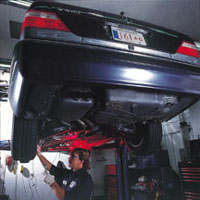Fill The Frame
Making The Most Of Medium Format
Medium format cameras are
hot, and with good reason. While many predicted that 35mm advancements
would slowly signal the demise of bulky medium format cameras, the exact
opposite has happened. Advances in film technology now make it possible
to get nearly 4x5 film quality from a 2x2" or 2x3" frame.
While view cameras certainly have their place in any pro photographer's
arsenal, a careful and creative photographer can use a medium format
camera and get images that reproduce full page and are nearly indistinguishable
from those taken with view cameras a decade ago. |
|||
While drum scans are at the
extreme end of the scanning spectrum, there are many reasonably priced
scanning solutions available today that are popping up on many a designer's
desk. Since I have to scan a lot of film for a number of different uses,
I combine a mix of drum scans, flat-bed scans, and scans from a dedicated
film scanner. I out-source the drum scans from a service bureau, and pay
anywhere from $50 to $130 for a 2500dpi scan. For years I used a 600x1200dpi
flat-bed scanner with a transparency adapter to scan medium format and
large format film. While the results were a far cry from a decent drum
scan, with a little work I could get a decent image. I never like to deliver
a job to a client that requires an explanation, so I would always be forced
to sharpen the heck out of the image to make it ready to deliver. Although
I was always able to deliver a file good enough for moderate reproduction
sizes, anything larger than a 5x7" reproduction from a 6x7cm original
started looking a little soft. To remedy this I looked into buying a drum
scanner of my own. With low-end drums starting at $20,000 and high-end
units well over $100,000, a drum scanner didn't seem like that wise
of an investment for my business. After a little shopping in the desktop
film scanner market, I bought a Minolta Dimâge Scan Multi medium
format film scanner from Ken-Mar Camera. |



































